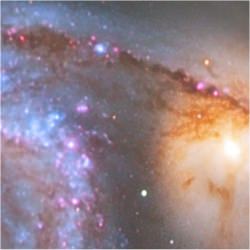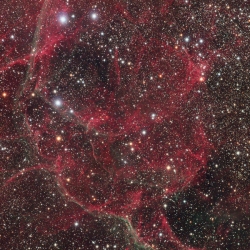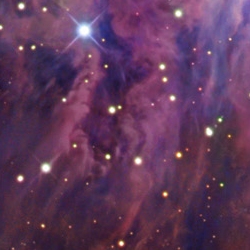Natural disasters are, unfortunately, something that we must contend with. For example, a flash flood can plunge towns into unexpected chaos, a hurricane strike can suddenly devastate an entire region and science has found evidence of an ancient asteroid impact that curtailed the rein of the dinosaurs by affecting climate across our planet. But these kind of events occur on an even greater scale – natural circumstances can lead to catastrophes that engulf whole galaxies such as seen in this picture.
Continue reading “Astrophoto: Centaurus A by Johannes Schedler”
Astrophoto: The North American and Pelican Nebulae by Don Goldman
We live in a universe filled with galaxies. Galaxies are vast gravitationally bound aggregations of hydrogen gas clouds, stars that are produced when part of a cloud collapses under its own enormous weight, atoms that have been ionized by stellar radiation and dust formed from the remnants of previous stars that have either exploded or thrown off their outer layers during old age. Of these, the largest directly observable constituents are the hydrogen gas billows. Older terms survive within the astronomical lexicon. Any extended object in the sky (other than the Sun, Moon, planets and comets) has at one time or another been called a nebula. The root meaning, however, is cloud and it’s now most often used to reference places that contain gas and dust such as the view provided by the image accompanying this article.
Continue reading “Astrophoto: The North American and Pelican Nebulae by Don Goldman”
Astrophoto: The Goldilocks Variable in the Dumbbell Nebula by Stefan Heutz
We are very fortunate, and perhaps lucky, to inhabit a planet near a star whose behavior has been relatively monotonous for billions of years. This is a vital quality of any star to spawn and support life. But, there are many suns that do not have this characteristic. These suns regularly increase their radiance by outpouring dramatic amounts of additional energy such as the Goldilocks variable star that can sometimes be seen in images of the Dumbbell Nebula, pictured here.
Continue reading “Astrophoto: The Goldilocks Variable in the Dumbbell Nebula by Stefan Heutz”
Astrophoto: The Crescent Nebula by Nicolas Outters
Nothing lasts forever. Even the stars in space have a beginning and an end. The length of time that a star shines is based on the amount of material and energy it contains which is also referred to as its mass. Stars shine by changing its lightest material into something heavier. This initially begins by converting hydrogen into helium through a process called nuclear fusion. It also releases massive amounts of energy which we see as (sun or) star light. But every star has a finite amount of hydrogen and once it is depleted the star’s fate is based on the mass of what it still possesses.
Continue reading “Astrophoto: The Crescent Nebula by Nicolas Outters”
Astrophoto: Just North of Antares by Steve Crouch
When you gaze towards a clear moonless night sky, the stars appear as points of light – most are colorless. There are a few exceptions, however: Mars, Aldebaran and the star at the heart of the constellation Scorpius, Antares, can be seen to have a very slight reddish hue. Through a small telescope, star and planetary colors become more apparent but galaxies and nebulas remain un-pigmented and monochromatic. These objects begin to take on a greenish ting when viewed through very large telescopes but rarely show the rainbow of hues seen in many deep space pictures, like the one shown here.
Continue reading “Astrophoto: Just North of Antares by Steve Crouch”
Astrophoto: M83 by Michael Sidonio
Scientists have known the universe is expanding for over eight decades. During this period, many speculated that gravity would eventually slow and halt the expansion then the universe would probably start to contract. This common view held that the universe repeatedly oscillated between Big Bang and Big Crunch. Then, in the late 1990’s, some scientists realized that the brightness of exploding stars in very remote galaxies were not following the predicted theoory. They concluded that the expansion of the universe was not decelerating. It is speeding up.
Continue reading “Astrophoto: M83 by Michael Sidonio”
Astrophoto: The Whirlpool Galaxy by Robert Gendler

The Whirlpool Nebula by Robert Gendler
Looking up into the midnight sky, with a faint cool breeze at your neck and the stars scattered like shards of glass caught in a spotlight, you can gain a sense of serenity. From gazing on the face of forever, your contemplations move from this bright star to that planet overhead. Yet, the universe is filled with routine violence on a scale that is unimaginably powerful and vast.
For example, untold numbers of objects fall to earth and are vaporized in a flash; mammoth tongues of flame leap from the Sun that would instantly incinerate our world we were any closer; and stars in the process of ending their useful lives suddenly implode and rip themselves into pieces during titanic blasts that briefly outshine the combined luminance of their home galaxy. These and many other events just as spectacular are common throughout the Universe. Safely tucked in our docile corner of the Milky Way galaxy, sequestered by a protective sea of air it’s easy to consider these events as abstractions that are curious but irrelevant to everyday life.
Perhaps our perspective would be quite different if our home planet was nestled within a galaxy that ventured too close to its neighbor, such as The Whirlpool Nebula (M51) or its yellow companion, NGC5195, pictured here. Our viewpoint about the nature of the Universe would most likely be quite different and we might quickly learn the consequences of trees falling in a forest even when no one was listening .
Placed within the northern constellation of Canes Venatici, this pair of entwined galaxies, 60 million light years distant, is one of nighttime’s most mesmerizing icons and a favorite target for sky gazers with binoculars or small telescopes. It’s a showpiece but light polluted skies wash away the view and render it unremarkable. But under dark skies hints of spiral structuring can be glimpsed with telescopes as small as 4 inches diameter.
The intense spiral arms of the larger galaxy are the result of its proximity to the smaller, more distant associate. When the two grew closer, the gravity of NGC 5195 induced ripples within the larger member. As these waves moved throughout the big spiral, the edge of each arm was squeezed and their original enormity was further accentuated. This energy formed storm clouds of gas and dark dust that eventually collapsed under their own gravity into dense areas of new star formation that are notably red. The stars these areas produced included massive short-lived members that terminated as supernovas. The winds blown from their massive explosions dissipated the clouds to reveal other new, bright clusters of stars that gave the arms a characteristic blue glow.
Meanwhile, the smaller galaxy became disrupted as its material was both thrown into intergalactic space and pulled into the larger spiral. Over time, these two will further distort and eventually merge through an ongoing spectacle of events that would capture the attention of any civilization possibly existing within either.
This exceptional picture of The Whirlpool Nebula was the result of an epic 42-hour exposure by Robert Gendler. Earlier this year, 21 hours was devoted to capturing black and white luminance data and the same amount of time was used gathering color information. Rob images from his Nighthawk Observatory located in the south central Sacramento Mountains of New Mexico using a 12 and 20 inch Ritchey-Chretien telescope equipped with an 11 mega-pixel camera.
Do you have photos you’d like to share? Post them to the Universe Today astrophotography forum or email them, and we might feature one in Universe Today.
Written by R. Jay GaBany
Astrophoto: The Vela Supernova Remnant by Loke Kun Tan

The Vela Supernova Remnant by Loke Kun Tan
About 11,000 years ago, around the dawn of human history, a fantastic stellar explosion took place relatively nearby our place in the galaxy. It left an aftermath covering nearly 40 degrees of the sky (the Moon and Sun extend only 1/2 a degree, for comparison), an aftermath captured by astrophotographer Loke Kun Tan.
The brilliance of this supernova explosion would have rivaled the quarter moon. According to an article in Science Digest, defects in the human cornea would have given this explosion the appearance of a dancing fire, hung low in the heavens if viewed from a location near the Mediterranean, shooting sparks of intense color in every direction like a fountain about the size of the full moon. The landscape would have been flooded with bands of shadows and pulsing illumination. It would have both awed and terrified any observer in antiquity.
Today, we can still see the remains of the conflagration as the Vela Supernova Remnant. It is located within the Gum Nebula, itself the result of an earlier star detonation. The remnant is in the southern constellation of Vela, about 1,300 light years distant – more than three times closer than the famous supernova seen by the Chinese in 1054, which, today, is marked by the Crab Nebula. This is a picture of the remnant’s central region; a growing shell of gas and dust that has enlarged to over 1,000 light years in diameter putting its leading edge only about 300 or 400 lights years from Earth and still expanding in all directions.
As the fast moving energy thrown off in the explosion slams into much slower moving gas and dust that occurs naturally throughout the space between the stars, it creates these beautiful shock wave fronts which glow like sinuous threads. Another view shows an extension of the upper part.
At the heart of the remnant glows a pulsar, the core of the star that exploded. It spins at over ten times per second and is the source of intense X-ray radiation.
Loke Kun Tan recently produced this image from thirty three separate shots that were digitally combined to create the equivalent of a six hour exposure. It was taken during a 2004 trip to La Frontera in Alcohuaz, Chile and was captured through a 4-inch refractor, designed specifically for wide field astrophotography, with an eleven mega-pixel astronomical camera.
Do you have photos you’d like to share? Post them to the Universe Today astrophotography forum or email them, and we might feature one in Universe Today.
Written by R. Jay GaBany
Astrophoto: The Orion Nebula by Rob Gendler

Image credit: M-42 by Rob Gendler
One of our galaxy’s nearest, and certainly most productive ranches is located only 1,500 light years from our planet, south in the sky-farmlands we call Orion the hunter.
Although invisible to unaided eyes, hold a camera’s shutter open for a while and it will reveal that the area is a vast fertile field of dust and molecular gasses where a bumper crop of new stars have been harvested and many times more are still ripening. One tract of this farm continues to produce blue ribbon winners each year for best of show – in fact, its yield is stellar! Situated below the three stars of Orion’s belt, it’s known as the Great Nebula or M-42.
Behold the flowering of nature’s bounty on an unimaginable scale – here spanning about forty five light years in width! This scene is seeded with open stellar clusters, nurseries hiding suns yet to be, fast moving jets and disks surrounding new stars, called proplyds. Much of the delicate filaments that appear to be blowing like willow branches on a breezy day result when fast moving material meets slower moving gas and dust to form massive waves. The sense of motion evident in this spectacular image is as real as it is mesmerizing.
This picture was produced by combining hundreds of separate images to form a single exposure totaling over ninety hours! It was taken by Rob Gendler (known for his green photographic thumb) from his remote controlled observatory in New Mexico’s south central mountains near the end of 2005.
Do you have photos you’d like to share? Post them to the Universe Today astrophotography forum or email them, and we might feature one in Universe Today.
Written by R. Jay GaBany
